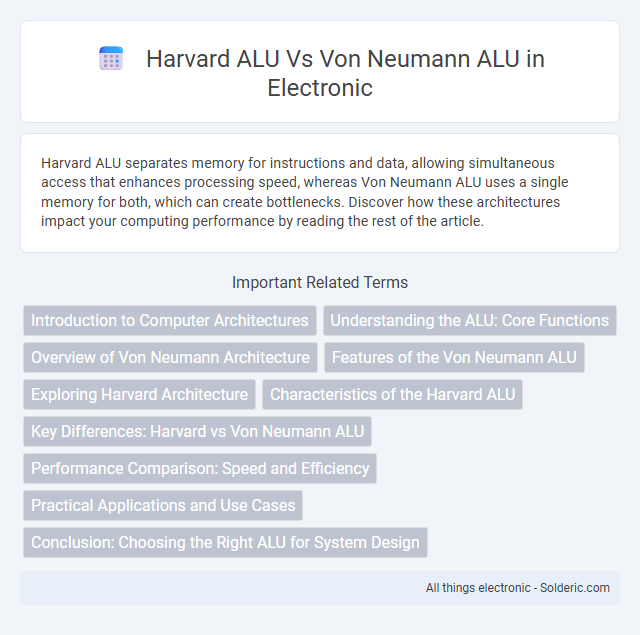Harvard ALU separates memory for instructions and data, allowing simultaneous access that enhances processing speed, whereas Von Neumann ALU uses a single memory for both, which can create bottlenecks. Discover how these architectures impact your computing performance by reading the rest of the article.
Comparison Table
| Feature | Harvard ALU | Von Neumann ALU |
|---|---|---|
| Architecture | Separate data and instruction memory | Single memory for data and instructions |
| Data and Instruction Paths | Separate buses | Shared bus |
| Memory Access | Simultaneous access to data and instructions | Sequential access, shared memory access |
| Speed | Faster processing due to concurrent access | Slower due to memory bottleneck |
| Complexity | Higher hardware complexity | Simpler hardware design |
| Use Cases | Embedded systems, DSP, real-time applications | General-purpose computing |
| Instruction Fetching | Parallel fetching and execution | Fetch and execution share the same memory path |
| Cost | Higher manufacturing cost | Lower cost due to simpler design |
Introduction to Computer Architectures
Harvard ALU and Von Neumann ALU represent two fundamental computer architectures differing in their handling of instructions and data; Harvard architecture uses separate memory spaces for instructions and data, enabling simultaneous access and faster processing, while Von Neumann architecture shares a single memory for both, which can lead to bottlenecks known as the Von Neumann bottleneck. Your choice between these architectures impacts system speed, complexity, and efficiency, as Harvard architecture suits high-speed, specialized applications, and Von Neumann supports simpler, more flexible designs. Understanding these distinctions is crucial for optimizing computer performance at the hardware level.
Understanding the ALU: Core Functions
The Harvard ALU processes data and instructions from separate memory spaces, enhancing parallelism and speed by allowing simultaneous access. The Von Neumann ALU, in contrast, handles both data and instructions through a unified memory, simplifying design but potentially causing bottlenecks due to sequential processing. Understanding these core ALU functions helps optimize your system's performance based on the specific computational needs.
Overview of Von Neumann Architecture
The Von Neumann ALU operates within the Von Neumann architecture, where a single memory stores both instructions and data, enabling sequential execution of programs. This architecture uses a single bus system for data and instructions, which can cause a bottleneck known as the Von Neumann bottleneck, impacting processing speed. Your computing tasks rely on this shared architecture, which contrasts with Harvard architecture's separate memory for data and instructions, offering potential performance improvements.
Features of the Von Neumann ALU
The Von Neumann ALU features a sequential processing design that performs arithmetic and logic operations using a single data path for both instructions and data, leading to the well-known Von Neumann bottleneck. It employs a unified memory system where data and instructions share the same storage, which simplifies hardware but can limit processing speed. Your understanding of this ALU highlights its reliance on a control unit to fetch, decode, and execute instructions in a step-by-step manner.
Exploring Harvard Architecture
Harvard ALU operates within a Harvard architecture that separates instruction and data memory, enabling simultaneous access and higher processing speeds compared to Von Neumann ALU, which uses a shared memory for instructions and data. This architectural distinction reduces bottlenecks in data throughput and enhances pipeline efficiency, making Harvard ALU ideal for embedded systems and digital signal processing. The separation in Harvard architecture allows parallel fetching and execution, improving overall computational performance and determinism.
Characteristics of the Harvard ALU
The Harvard ALU features separate memory spaces and buses for instructions and data, allowing simultaneous access that increases processing speed and efficiency. Your system benefits from reduced bottlenecks as the ALU can fetch instructions and perform data operations concurrently. This architecture enhances performance in embedded systems and digital signal processing by optimizing parallelism and throughput.
Key Differences: Harvard vs Von Neumann ALU
Harvard ALU architecture utilizes separate memory and data paths for instructions and data, enabling simultaneous access and faster processing speeds, while Von Neumann ALU employs a single shared memory for both, causing potential bottlenecks known as the Von Neumann bottleneck. Harvard ALUs often feature dedicated instruction and data buses, enhancing pipeline efficiency, whereas Von Neumann ALUs rely on a unified bus system that can limit throughput. The separation in Harvard ALU design supports parallelism and reduced latency, making it ideal for digital signal processing, contrasting with the more straightforward, cost-effective structure of Von Neumann ALUs commonly used in general-purpose computing.
Performance Comparison: Speed and Efficiency
Harvard ALU offers superior speed by concurrently accessing separate instruction and data buses, reducing memory access bottlenecks compared to the Von Neumann ALU, which uses a single shared bus. This architecture enables Harvard ALU to execute instructions more efficiently, minimizing latency and improving throughput. Von Neumann ALU, while simpler and more flexible, often experiences slower performance due to the sequential fetching and execution of instructions and data.
Practical Applications and Use Cases
Harvard ALUs excel in embedded systems and digital signal processing where parallel instruction and data access enhance performance, such as in microcontrollers and DSP chips. Von Neumann ALUs are widely used in general-purpose computing devices, including desktops and servers, where flexible program storage and simpler architecture optimize cost and versatility. The distinct memory architectures influence the choice based on application demands for speed, complexity, and power efficiency.
Conclusion: Choosing the Right ALU for System Design
Choosing the right ALU for system design depends on specific performance, complexity, and power requirements. Harvard ALUs offer improved speed and efficiency by separating instruction and data pathways, ideal for embedded and real-time systems. Von Neumann ALUs provide simpler architecture and flexibility, making them suitable for general-purpose computing where shared memory access is preferred.
Harvard ALU vs Von Neumann ALU Infographic

 solderic.com
solderic.com